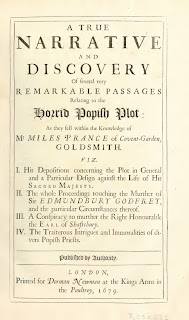Miles Prance was a Catholic goldsmith and maker of
religious emblems to Catherine of Braganza, Queen consort of King Charles II.
The self-styled ‘Captain’ William Bedloe, an adventurer who placed himself at the
heart of Titus Oates’s Popish Plot, spotted Prance either in a corridor or in
an eating-house and identified him as one of the men present when he had, he
claimed, seen the body of Sir Edmund Berry Godfrey in a darkened room at
Somerset House. Prance was arrested and left in a freezing cell, laden with
chains, at Newgate gaol and was coerced into confessing that he had been
involved in Godfrey’s murder.
 |
| The Rack |
He recanted his confession and was returned to
Newgate, where he was certainly tortured and was probably threatened with the
rack, which had been illegal in England for over fifty years, and made another
confession, which substantiated the story, in parts, given by Bedloe.
 |
| Prance - A Narrative of the Murther of Sir Godfrey |
On the
evidence given by Bedloe and Prance three men, Green, Berry and Hill, were found
guilty and hanged for the murder of Godfrey, which added credence to Oates’s
allegations that the English Catholics, and in particular the Jesuits, were
planning to assassinate the King and aid an invasion from the continent,
overthrowing the government and re-establishing a Catholic monarchy, possibly
with James, Duke of York and the King’s Catholic brother, as its figurehead.
Oates’s claims had been threatening to falter and the Godfrey case regenerated
interest and provided credibility for them, adding impetus and creating an
anti-Catholic paranoia in England.
 |
| Miles Prance - A True Narrative - 1679 |
Prance’s version of events A True
Narrative and Discovery appeared in 1679, and reveals glaring discrepancies
betwen his and Bedloe’s account, whilst also containing numerous examples of
crimes, plots and indiscretions committed by English Catholics and Jesuit
priests. Nevertheless, Prance was retained, provided further evidence in trials
initiated by Oates, and received ‘special’ payments by the secret service.
Prance also proved that Sir Roger L’Estrange, Oates’s most vociferous and
dangerous critic, was secretly a Catholic, thereby removing the plot’s most
formidable opponent.
 |
| The Answer of Miles Prance - 1684 |
Several years after the plot had been proven to be the
invention of Oates, charges of perjury were brought against Prance and in 1686,
he was found guilty and sentenced to a fine of £100, to be thrice pilloried and
whipped through the streets from Newgate to Tyburn, although this last part was
remitted at the intervention of the King. This is odd, as the remaining sentence
was remarkably light and it is likely that a deal had been struck beforehand.
Prance admitted his perjury, claiming that he had been forced into it through
‘fear and cowardice’.
 |
| Miles Prance |
And then the story gets really weird. In 1689,
following the Glorious Revolution, Miles Prance attempted to escape from
England by boarding a hoy Asia, bound from Gravesend to Dunkirk. This,
in itself, was not unusual, as many Catholics followed the deposed King James
into continental exile. Prance was aboard one of the last boats rowing
passengers out to the Asia when the officers of the harbour seized the
boat and arrested those already aboard the ship. What is unusual is Prance’s
travelling partner - Father John Warner, the late provincial of the Jesuits in
England, former rector of St Orme’s and once confessor to King James II, making
him the most important Jesuit in England.
Why was he, of all people, travelling
with Prance? He obviously knew him, and knew what he had done. He knew that his
perjury had sentenced two innocent Catholics to death. He knew that his True
Narrative and Discovery had exposed numerous other Jesuits to immense
danger. He presumably appreciated that Prance might reveal his identity at any
time, when detection would lead to imprisonment and maybe even death.
And why
was Prance fleeing England? It is true that his confession that his accusations
against the Catholics were false would not endear him to the new
administration, but he had only to claim that they had been extorted under
duress and retract them, to then live in relative safety. Why on earth was he
going to France, where there were Catholics enough to resent his former lies?
And why was he, of all people, travelling with Father Warner?
 |
| A Remonstrance of Piety - 1683 |
There can only be
one logical explanation. Miles Prance had been a Jesuit double agent all along.
This explains the lenient, almost trifling, sentence for his perjury. The King
and Father Warner knew his true identity. Warner and Prance escaped from
captivity and separated. Warner took a ship from Maidstone using a false
passport, and made it to France. Prance was retaken and the Mayor of Gravesend
sent him to the House of Lords for questioning, but no proceedings were taken
against him and it seems likely that he eventually lived out the rest of his
days abroad, most probably in France.
No comments:
Post a Comment